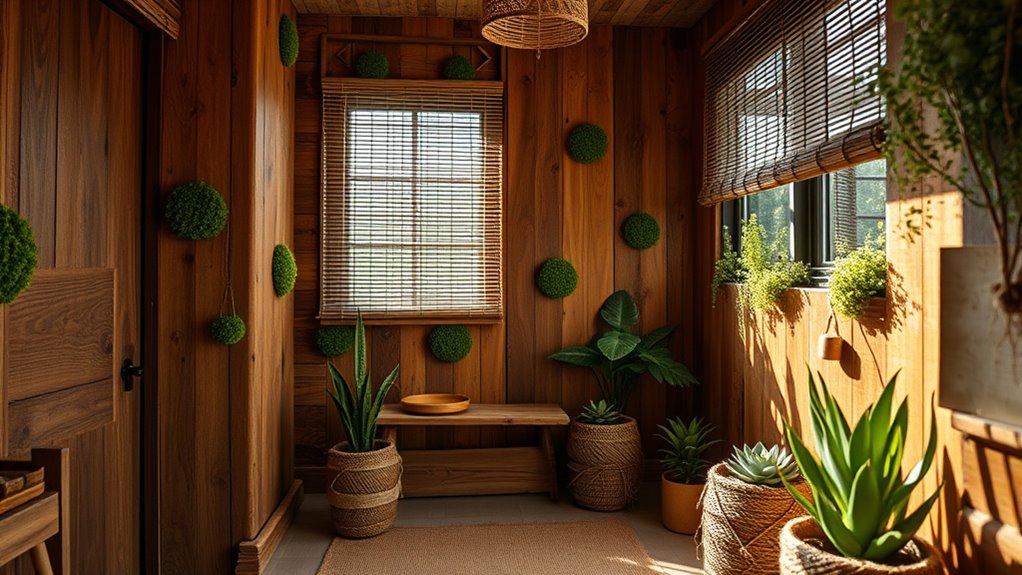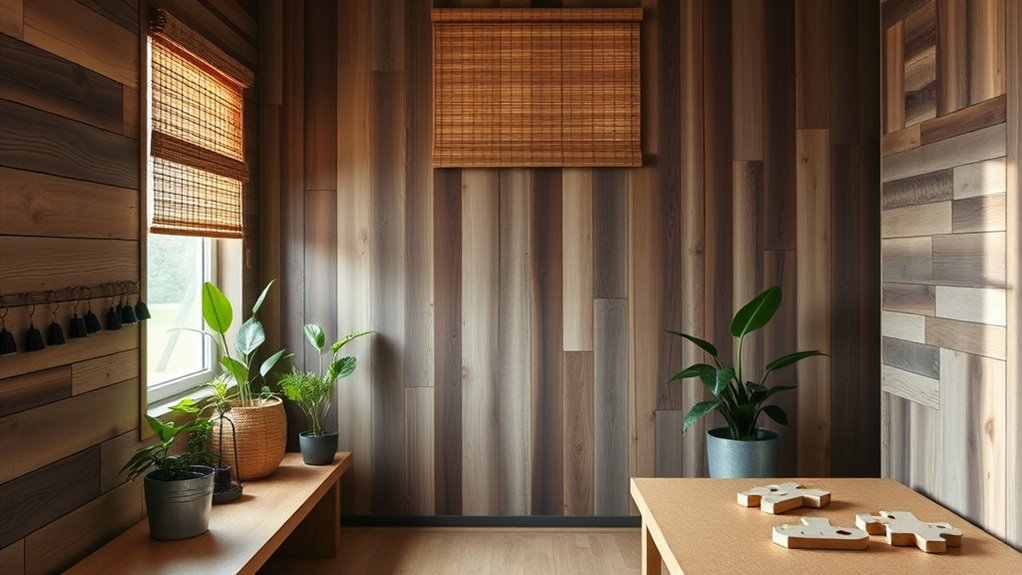For your escape room, choosing sustainable materials like reclaimed wood and eco-friendly adhesives is a smart move. Reclaimed wood adds unique charm and reduces waste, while eco-friendly adhesives lower harmful VOC emissions and support green practices. Together, they create a durable, authentic environment that’s gentle on the planet. Incorporating these materials not only boosts your eco credentials but also offers creative flexibility. Keep exploring to discover how to design a truly eco-conscious escape room.
Key Takeaways
- Use eco-friendly adhesives to ensure strong bonds while minimizing VOC emissions and environmental impact.
- Incorporate reclaimed wood from old structures for authentic aesthetics and sustainable resource conservation.
- Reclaimed wood reduces waste, supports biodiversity, and extends material lifespan in escape room design.
- Combining sustainable adhesives and reclaimed wood promotes a low ecological footprint in construction.
- Digital tools can optimize material use, enabling creative reuse and reducing waste in eco-conscious escape room projects.

Creating escape rooms that are both engaging and environmentally responsible is more important than ever. As you design your space, choosing sustainable materials becomes a key part of your mission. One of the first steps you can take is to incorporate eco friendly adhesives. These adhesives are specially formulated to reduce volatile organic compounds (VOCs) and minimize harmful emissions, making them safer for both your team and the environment. Using eco friendly adhesives ensures that your construction process aligns with green practices without sacrificing durability or quality. They work well for assembling puzzles, fixtures, and decorative elements, providing a strong bond while keeping your ecological footprint low. Combining these adhesives with other sustainable choices makes your project more eco-conscious from start to finish.
Another crucial material to contemplate is reclaimed wood options. Reclaimed wood isn’t just trendy; it’s a smart choice for reducing waste and conserving natural resources. When you opt for reclaimed wood, you’re giving new life to wood that might otherwise end up in a landfill. This type of wood often comes from old buildings, barns, or shipping pallets, offering unique textures and character that can add authenticity to your escape room’s aesthetic. Reclaimed wood is often more durable because it’s seasoned and aged, which means it can withstand the wear and tear of frequent use. Plus, sourcing reclaimed wood reduces the demand for freshly harvested timber, helping protect forests and biodiversity. Additionally, utilizing AI-driven analytics can help optimize material usage and reduce waste during construction, further supporting your sustainability goals.
Using reclaimed wood options also gives you creative flexibility. You can repurpose it for walls, furniture, or decorative accents, creating an environment that feels authentic and eco-friendly. It pairs well with other sustainable materials, allowing you to craft an immersive experience while sticking to your green principles. When combined with eco friendly adhesives, reclaimed wood becomes even more sustainable, as you reduce the need for chemical treatments and new resource extraction.
Frequently Asked Questions
How Do Sustainable Materials Impact Overall Escape Room Costs?
Sustainable materials can initially raise your escape room costs, but they often lead to savings in the long run. You’ll find a positive cost comparison due to durability and lower maintenance needs. While supplier availability might be limited, sourcing eco-friendly options is becoming easier and more affordable. By choosing sustainable materials, you not only support environmentally conscious practices but also enhance your escape room’s appeal to eco-minded customers.
What Are the Durability Differences Between Eco-Friendly and Traditional Materials?
You’ll find that eco-friendly materials often have a comparable material lifespan to traditional options, though some may wear more quickly depending on usage. Generally, eco-friendly choices like bamboo or recycled composites are resistant to wear, but their durability can vary. You should consider resistance to wear and overall lifespan to make certain your escape room remains intact over time, balancing sustainability with the needed durability for frequent use.
Are Sustainable Materials Suitable for High-Traffic Escape Room Environments?
Yes, sustainable materials like biodegradable plastics and recycled wood are suitable for high-traffic escape rooms. They’re durable enough to withstand frequent use, especially when properly treated or sealed. These eco-friendly options can handle wear and tear while reducing environmental impact. You’ll find that they not only support sustainability goals but also maintain the quality and safety needed for busy escape room environments.
How Do Sustainable Materials Influence Indoor Air Quality?
Sustainable materials improve indoor air quality by reducing air pollutant levels and VOC emissions. When you choose eco-friendly options, you decrease the risk of harmful fumes, creating a healthier environment for visitors and staff. These materials emit fewer pollutants, helping to maintain cleaner air and minimize respiratory issues. By prioritizing sustainable choices, you guarantee a safer, more comfortable escape room experience that supports overall well-being.
What Certifications Should I Look for in Eco-Friendly Construction Materials?
You should look for materials with reputable eco label standards and green certification programs. These certifications, like LEED or FSC, act as proof of eco-friendly practices, ensuring the materials meet strict environmental criteria. Imagine confidently building your escape room, knowing each piece has passed rigorous standards. These certifications guarantee you’re choosing sustainable options that support healthy indoor air quality, reduce environmental impact, and align with your eco-conscious goals.
Conclusion
So, as you build your eco-friendly escape room, remember that choosing sustainable materials isn’t just good for the planet—it’s ironically the most unexpected way to create a trap. With eco-conscious wood and recycled decor, you might think you’re saving the environment. But watch out—your guests could end up more entangled in guilt than in your puzzles. After all, who knew saving the Earth could be the ultimate puzzle? Now, go open that green masterpiece!









